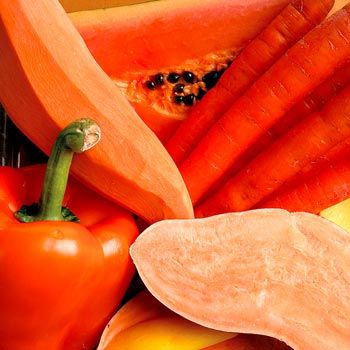Medical expert of the article
New publications
11 glorified nutrients: What do we need them for?
Last reviewed: 04.07.2025

All iLive content is medically reviewed or fact checked to ensure as much factual accuracy as possible.
We have strict sourcing guidelines and only link to reputable media sites, academic research institutions and, whenever possible, medically peer reviewed studies. Note that the numbers in parentheses ([1], [2], etc.) are clickable links to these studies.
If you feel that any of our content is inaccurate, out-of-date, or otherwise questionable, please select it and press Ctrl + Enter.

Beta-carotene
Mechanism of action:
Once in the body, beta-carotene is converted into vitamin A, a nutrient essential for healthy vision, immune system, and cell growth. It also acts as an antioxidant, neutralizing free radicals.

Recommended dosage:
There is no recommended dosage for beta-carotene.
Food sources of beta-carotene:
Eat plenty of dark green and orange vegetables and fruits (papaya, mango) each week to meet your vitamin A needs and take advantage of its potential antioxidant properties.
B12
Mechanism of action:
Vitamin B12 is used in the formation of DNA, the building block of genes, and in maintaining healthy nerves and red blood cells.
Recommended dosage:
2.4 micrograms per day for people over 14 years of age fully meets the body's need for this element - although some scientists believe that consuming 6 micrograms per day promotes better absorption of the vitamin.
Food sources of B12:
B12 is bound to protein, so foods such as meat, fish, eggs and dairy products (such as yogurt and milk) are its main sources.
 [ 1 ]
[ 1 ]
Chromium
Mechanism of action:
Chromium is involved in the process of producing useful energy from energy sources, facilitating the entry of glucose into insulin cells.
Recommended dosage:
Despite disappointing research on the effects of chromium supplements on weight loss, the body needs this element. The recommended daily dose for adults is 50-200 micrograms.
Food sources of chromium:
The best sources of chromium are whole grain breads and cereals, meat, nuts, plums, raisins, beer and wine.
 [ 2 ]
[ 2 ]
Vitamin K
Mechanism of action:
Vitamin K is used by the body to produce a number of different proteins. Some of these are used to create factors that enable the blood clotting process – which is vital for stopping bleeding and healing wounds and cuts.
Recommended dosage:
The current recommended daily intake is 90 micrograms for women and 120 for men. Fortunately, vitamin K deficiency is extremely rare.
Food sources of vitamin K:
Cabbage, spinach, broccoli, asparagus, arugula, lettuce, canola, soybean and olive oil, tomatoes.
Potassium
Mechanism of action:
Potassium is involved in almost all vital processes in our body: maintaining blood pressure, heart and kidney function, muscle contraction, and even digestion.
Recommended dosage:
Surveys show that many people consume less than half the recommended intake of potassium, which is 4,700 mg per day for adults and adolescents.
Food sources of potassium:
Foods that are close to their original state are best, so make sure you eat unprocessed foods, especially fruits and vegetables, low-fat dairy products, whole grains, fish, and lean meats.
Magnesium
Mechanism of action:
Essential for some of the most important processes in our bodies, magnesium powers around 300 biochemical reactions, the most important of which is the production of energy from the food we eat.
Recommended dosage:
About 300 mg per day for women and 350 mg for men, the upper limit for magnesium supplements is 350 mg.
Food sources of magnesium:
The mineral is found in large quantities in avocados, nuts and leafy greens, as well as kiwi, almonds and acorn squash.
Vitamin C
Mechanism of action:
It has long been known that vitamin C is a fundamental component of collagen, the structural element of bones, skin, blood vessels and other tissues.
Recommended dosage:
The current recommended dose is 90 mg per day for men and 75 mg for women. The body can absorb a maximum of 400 mg per day.
Food sources of vitamin C:
Almost all vegetables and fruits, including oranges, green bell peppers, strawberries, broccoli, cantaloupe and tomatoes, turnips, sweet potatoes and okra.
Vitamin D
Mechanism of action:
Vitamin D is primarily beneficial for bones because it interacts with calcium to help form and protect bones.
Recommended dosage:
Official recommendations are 200 international units for children and 600 for people over 71. The dose for everyone else can vary between these figures.
Food sources of vitamin D:
Food sources of vitamin D include mainly fortified milk and breakfast cereals. Aside from a few types of fish, including herring and sardines, there are no natural food sources of vitamin D, leaving only direct sunlight and supplements.
Folate/Folic acid
Mechanism of action:
Folic acid is needed to form new cells, including red blood cells. Folic acid deficiency is a leading cause of spinal defects in newborns.
Recommended dosage:
Many nutritionists recommend taking a multivitamin that contains 400 micrograms of folate; 1,000 micrograms per day is the safe upper limit for folate.
Food sources of folate:
Folic acid is found in abundance in liver, dried beans, peas, spinach and leafy greens, asparagus and fortified cereals.
Zinc
Mechanism of action:
Zinc is an integral part of almost all cells in the human body, and among other functions, it supports a healthy immune system and regulates testosterone levels.
Recommended dosage:
The daily recommended dose is 11 mg for men and 8 mg for women.
Food sources of zinc:
Oysters, cooked beef tenderloin, turkey, garbanzo beans, roasted chicken legs, pumpkin seeds, cooked pork tenderloin, low-fat yogurt, tofu, wheat germ, roasted cashews and Swiss cheese.
Vitamin E
Mechanism of action:
Scientists have not yet shed light on all of the functions of vitamin E, but they suggest that it influences the immune system, DNA repair, red blood cell formation, and vitamin K absorption.
Recommended dosage:
The recommended dosage is 23 international units or 15 mg for men and women because nuts and oils contain large amounts of vitamin E and some low-fat diets contain inadequate amounts of vitamin E.
Food sources of vitamin E:
Wheat germ oil. Seeds, cooked spinach, almonds, hazelnuts and safflower oil.

